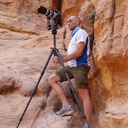0 Likes
Bajo de Véliz
Mas panoramas en: http://www.altavista360.com.ar/
...





Argentina didn't get to be the second-largest country in South America overnight. Archaeological remains found here date to some 9,000 years BC, left by the ancient Mesoamerican civilization. Early inhabitants were nomads and hunters who followed prehistoric horses and llamas. By the year 1480 AD the Incan empire had stretched to reach northern Argentina and the stage was set for contact.The Europeans came in 1516 with Spanish explorer Juan Diaz do Solis, who claimed the area for Spain and tried to export a river of silver back to Europe. Wealth grew along with the cattle industry and after Napoleon conquered Spain, Argentina declared its independence and set up their own government. That was 1810 AD.Argentina stayed neutral in WWI and for most of WWII, declaring war on the Axis powers only in 1945. Following the war, the country entered into a long chain of military dictatorships with only brief forays into constitutional government. The current president is Cristina Fernandez de Kirchner, who's been in office since December 2007.Argentina is known for many things but the top of the list belongs to only two -- steak and the tango. Cattle graze on the abundant grasslands and produce some of the best beef in the world. The climate is well-suited for vineyards as well, and Argentina's wines make a fine companion to their steak.As for the tango, it has recently exploded to become a world famous dance with hotspots in every major city on the planet. It started in Buenos Aires in the middle of the nineteenth century, as the city was filling up with a mixture of European immigrants and porteños, people who were born in the port city. They melded their cultures of rhythm and harmony and came up with the tango, which has been described as the ultimate evolution of partnered dancing. And it's a great way to burn off your steak stupor. Food coma begone!Text by Steve Smith.